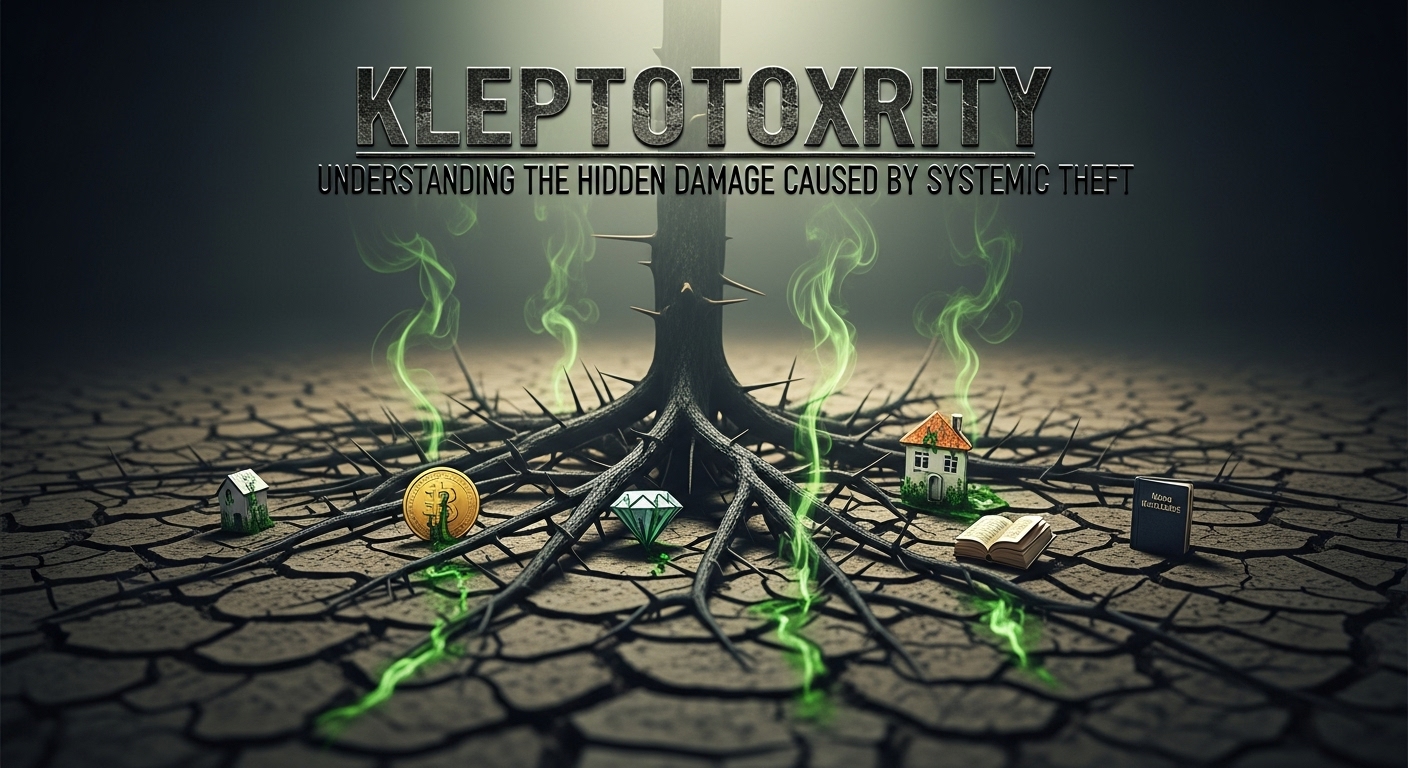The term “kleptotoxicity” is an emerging concept used to describe the harmful, long-term effects of persistent theft, especially when committed by individuals, corporations, or governments in positions of power. Much like “toxicity” refers to harmful exposure that accumulates over time, kleptotoxicity refers to the cumulative damage caused by ongoing acts of theft, corruption, or resource extraction.
While not yet a formal scientific term, it is increasingly used in academic discussions, policy conversations, and social analysis to illustrate how stealing—whether financial, intellectual, cultural, or environmental—creates consequences that extend far beyond the act itself.
What Is Kleptotoxicity?
Kleptotoxicity combines two ideas:
-
Klepto-: from the Greek kleptein, meaning to steal
-
Toxicity: the quality of causing harm, decay, or dysfunction
Together, the term describes the destructive impact of theft on systems, communities, institutions, and individuals.
Kleptotoxicity highlights that theft is not simply a momentary loss—it generates:
-
long-term damage
-
structural inequality
-
loss of trust
-
erosion of stability
-
psychological and economic harm
The concept applies to both micro-level theft (personal misconduct) and macro-level corruption (institutional or governmental theft).
The Different Forms of Kleptotoxicity
Kleptotoxicity is not limited to financial theft. It covers a wide spectrum of harmful extraction.
1. Economic Kleptotoxicity
This refers to the damage caused when financial theft becomes widespread or systemic.
Examples include:
-
Corporate embezzlement
-
Public sector corruption
-
Misuse of tax money
-
Financial fraud
-
Resource siphoning by elites
Economic kleptotoxicity often results in:
-
budget deficits
-
underfunded healthcare or education
-
rising poverty
-
reduced investor confidence
-
collapsing public services
Even small acts can accumulate into widespread dysfunction.
2. Environmental Kleptotoxicity
This form describes the theft of natural resources and its long-term consequences.
Examples:
-
Illegal logging
-
Unregulated mining
-
Poaching
-
Pollution produced without accountability
-
Water or land appropriation
Environmental kleptoto-xicity harms biodiversity, weakens ecosystems, and jeopardizes the well-being of future generations.
3. Intellectual and Creative Kleptotoxicity
This occurs when ideas, research, art, or culture are stolen or exploited without credit.
Examples:
-
Plagiarism
-
Uncredited art reproduction
-
Patent theft
-
Stealing indigenous cultural practices
-
Copying technology or scientific discoveries
This form of kleptotoxicity stifles innovation, discourages creators, and undermines knowledge-based industries.
4. Institutional Kleptotoxicity
When corruption becomes normalized within institutions, kleptotoxicity can spread like a toxin.
Effects include:
-
decay in rule of law
-
public mistrust
-
weakened democratic processes
-
biased decision-making
-
erosion of accountability
Institutions affected by kleptotoxicity often struggle to regain legitimacy.
5. Social and Psychological Kleptotoxicity
Theft also produces invisible emotional and social damage.
Impact includes:
-
trauma for victims
-
breakdown of trust in communities
-
normalization of unethical behavior
-
increased fear and insecurity
-
resentment toward authorities
Social kleptoto-xicity can destabilize entire societies if left unaddressed.
How Kleptotoxicity Spreads
Like toxicity in biology, kleptoto-xicity has a cascading effect. Once theft becomes frequent or accepted, it can spread through:
1. Cultural Normalization
If people believe “everyone is taking something,” it encourages further misconduct.
2. Weak Institutions
Poor oversight and lack of accountability make theft easier and more attractive.
3. Inequality
When wealth or resources are captured by a small group, kleptoto-xicity deepens social divides.
4. Lack of Transparency
Opaque decision-making hides the flow of money, resources, and power.
5. Leadership Failure
Corrupt leaders can influence entire organizations or states to adopt kleptocratic practices.
Consequences of Kleptotoxicity
The consequences of kleptotoxicity reach far beyond the immediate act of theft. Its impact can be:
1. Economic Breakdown
Resources that should support public welfare are diverted, resulting in:
-
declining infrastructure
-
weaker economies
-
loss of foreign investment
-
unemployment
2. Social Fragmentation
Communities lose their sense of safety and connection.
3. Moral Erosion
Ethical standards weaken; dishonesty becomes normalized.
4. Institutional Collapse
Government bodies and public services can become ineffective.
5. Long-Term Environmental Damage
Natural resources may become depleted or contaminated.
6. Generational Harm
Future generations inherit weakened systems, damaged ecosystems, and reduced opportunities.
How to Combat Kleptotoxicity
Addressing kleptoto-xicity requires systemic solutions:
1. Transparency and Accountability
Public access to information reduces opportunities for theft.
2. Strong Legal Systems
Clear laws and consistent enforcement help deter misconduct.
3. Democratic Participation
Active civic engagement holds institutions accountable.
4. Ethical Education
Cultivating values of integrity, fairness, and responsibility is essential.
5. Environmental Protection
Safeguards against resource exploitation reduce ecological kleptotoxicity.
6. Support for Creators and Innovators
Protecting intellectual property encourages growth and creativity.
Why the Concept Matters Today
The idea of kleptotoxicity is becoming more relevant because:
-
global corruption levels remain high
-
environmental theft is accelerating
-
misinformation and digital theft are increasing
-
trust in institutions is declining in many regions
-
inequality continues to widen
Kleptotoxicity provides language to describe how deeply theft damages societies, helping policymakers, activists, and researchers frame the issue as a systemic toxin rather than isolated wrongdoing.
Conclusion
Kleptotoxicity is a powerful concept for understanding the destructive ripple effects of theft in all its forms. It highlights that stealing is not a private act but a phenomenon that weakens economies, undermines trust, damages ecosystems, and destabilizes communities.
As global challenges grow more complex, recognizing kleptotoxicity helps societies address not only the act of theft but also the deeper structures that allow it to flourish. The more clearly we understand these toxic patterns, the better equipped we become to build transparent, fair, and sustainable systems for the future.

